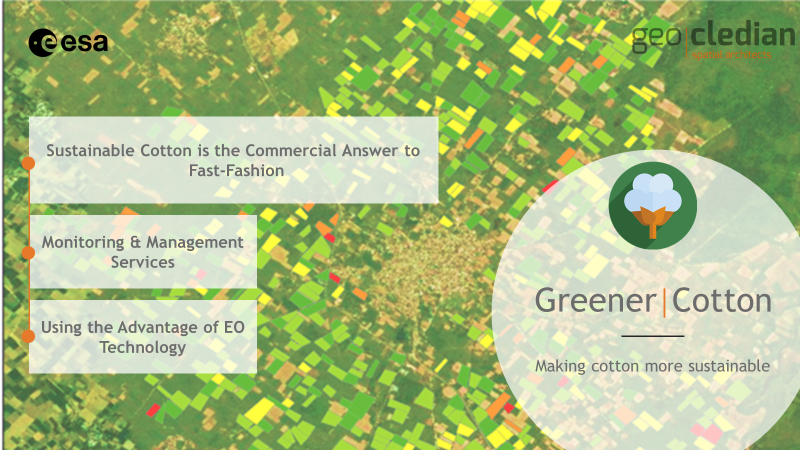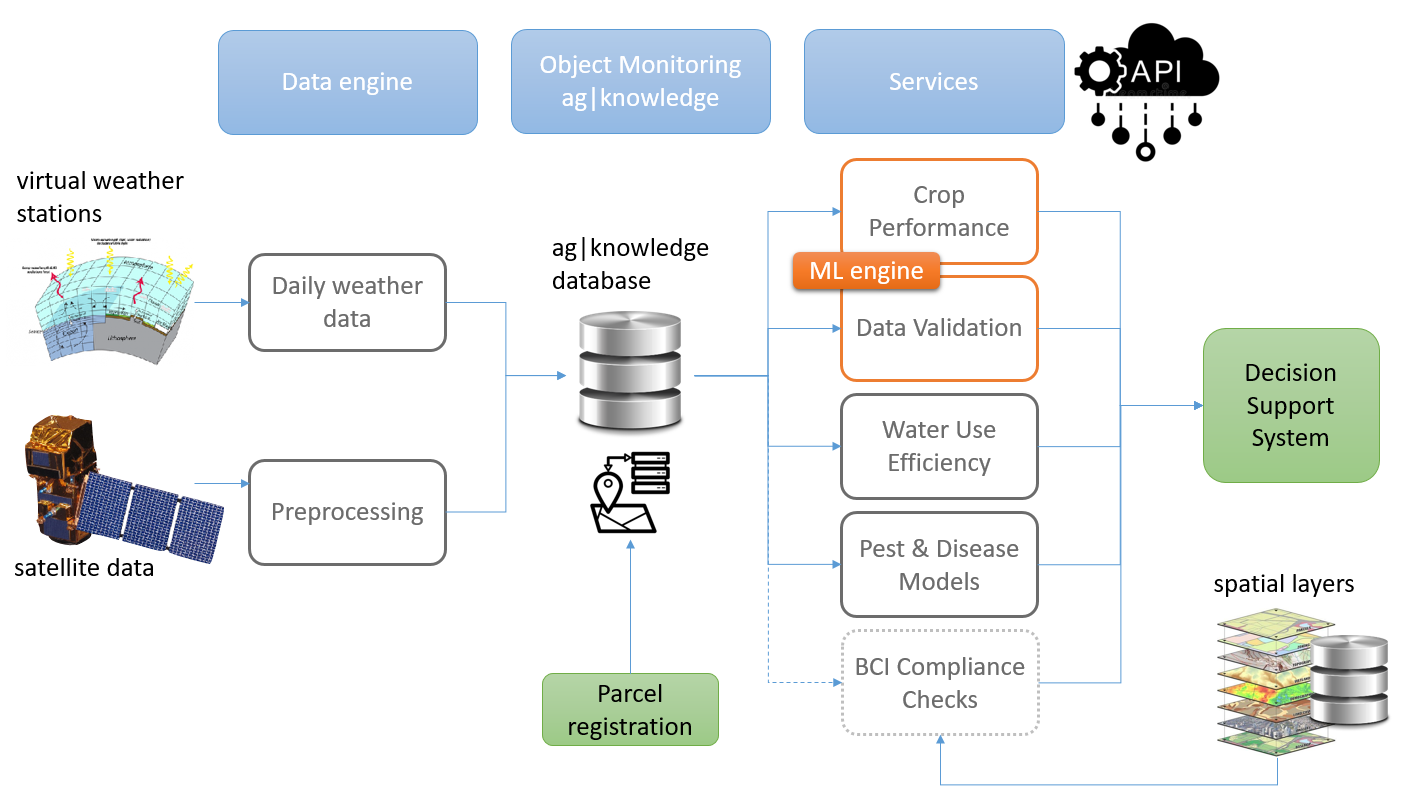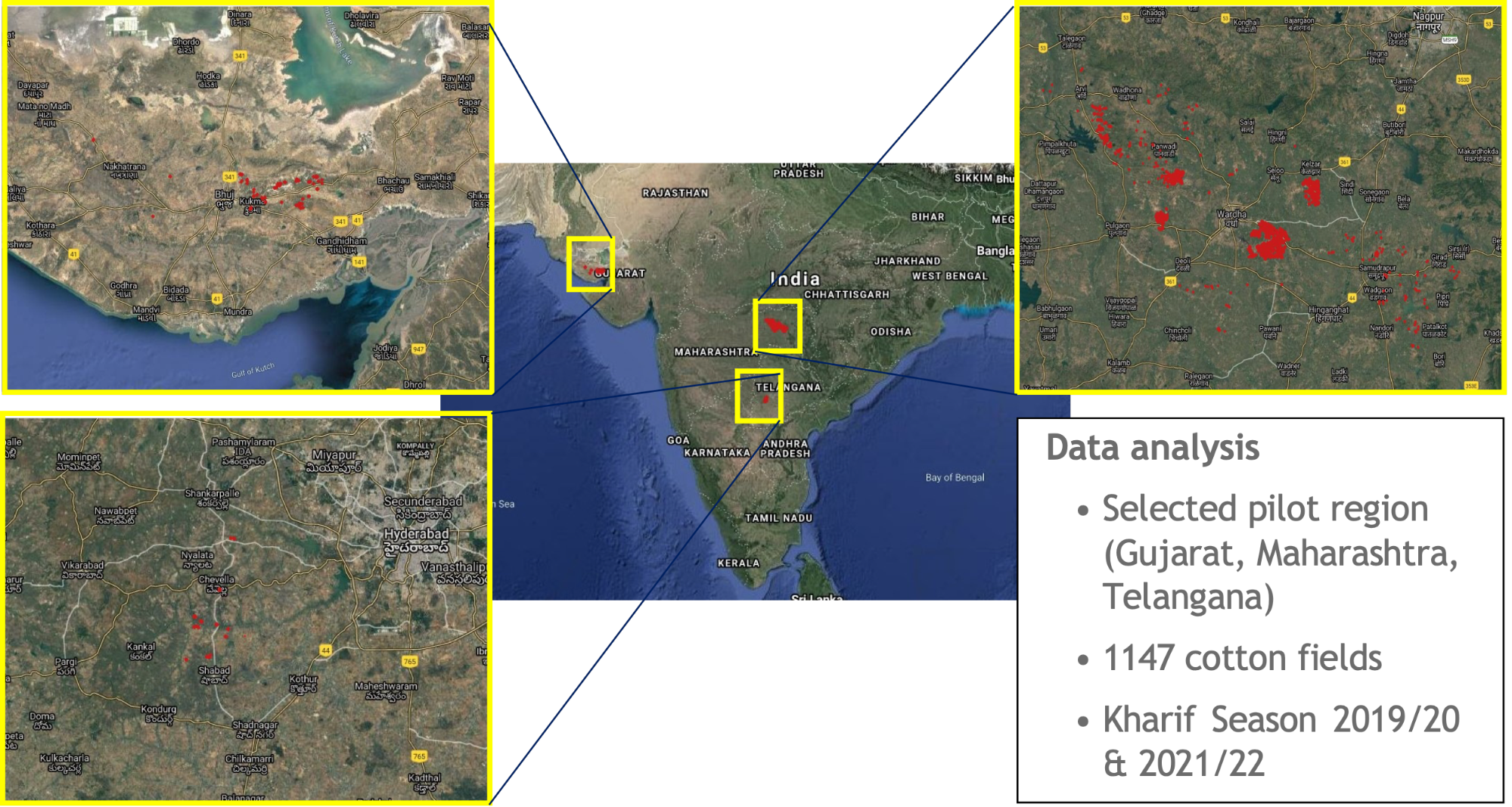
Objectives of the service

Cotton is the main natural fiber used by the global textile industry. World production reached 26M tons last year. The 5 major producers are China, India, USA, Brazil and Pakistan. However, most cotton is still grown in a classic, unsustainable way. This circumstance led to the creation of several sustainable cotton standards.
The Greener|Cotton aims to substantially improve and support sustainable cotton production by the application of satellite based digital agriculture technology. Integrated into cotton local management solutions, Greener|Cotton will help to reduce resources and thus costs, allow to better manage production risks, improve cultivation, leading to increased fiber quality, yields and revenues of producers. It will support extension services to provide services more efficiently and at a higher quality.
Satellite data and GIS technology will enabling the required transparency on productive areas and real production volumes. It will allow to check land responsibility maintaining key biodiversity areas or protecting rivers. Thus, it will help to enhance trust and commercial value of the labels.
These benefits will be enabled by a comprehensive set of micro services for data capture and validation, crop growth, health and drought monitoring, water efficiency management, disease risk assessment, harvest optimization and yield estimation.
Users and their needs
Greener|Cotton targets the following main users groups:
-
Extension Services
-
Ginneries
-
Traceability platforms
-
Auditors
Countries with small and medium farmers like India, Pakistan, China, Africa, Turkey and Greece will be mainly targeted.
Extension services advise farmers on agricultural methods, implement certification methods and standards. Optimizing workflows reducing costs will be the key benefit of Greener|Cotton.
Ginneries or raw cotton processors typically contract farmers to produce cotton of a certain quality. They either contract the extension services or operate the extension services themselves.
Traceability solutions are used by the extension services and ginneries for data recordings, analysis and transparency. They are also a source of information for the downstream supply chain including auditors. This puts them in a central role in data management and distribution.
The auditing bodies are controlling the compliance against such standards. They are users of the services in particular in respect to the prevention of identity fraud and increased transparency. Most of them act internationally. In some cases operate also traceability platforms and are offering them to the implementation partners (extension services).
Two major stakeholders still have to be named: smallholders and standardization bodies. Smallholders become indirect users of the services taking advice from extension services derived from our services, while standardization bodies have an interest that their standards are and remain trustworthy.
Service/ system concept
The overall system of Greener|Cotton is intended to provide value added services for cotton farming, using remote sensing and weather data. The defined services support the digital data management, validation and data analytics for cotton-relevant information extraction that also supports the criteria on sustainable land use management. The services may work on two levels: a regional level or a more precise parcel level.
Greener|Cotton will provide the following services:
-
Prevent identity fraud – containing:
-
Data Validation Service
-
-
Production monitoring – containing:
-
Crop performance monitoring
-
Yield assessment
-
-
Supporting sustainability farming – containing:
-
Agronomical weather and forecast
-
Water use efficiency service and irrigation advisory
-
Disease and pest risk management
-
Land responsibility
-

The main system components are a data preprocessing engine managing input data sources, an object management system for management parcel data cubes and core analytical capabilities, a service generation layer for efficient data analysis and an API interface layer to allow for REST-requests for the provision of the different services in well-defined JSON response models to the final decision support system.
Space Added Value
Greener|Cotton is built on top of our Ag|Knowledge 4.0 platform, making intensive use of various space assets, primarily of the Copernicus Sentinels, ECMWF and other weather models but also of Landsat 8/9, Modis and HHR/VHR data. All positioning for geofencing information will be based on the GNSS systems Galileo, GPS and others. The added value of EO technologies is to provide objective and continuously updated information at low costs by at the same time covering up to 100% of the area requested. Professional field visits may provide a higher local level of detail but having a lower spatial coverage and even more important a lower frequency at higher costs. Moreover, the advantage of EO technology allows:
-
independent and frequent cotton monitoring and reporting on cotton production and land use management
-
cotton monitoring and agricultural information extraction for remote and inaccessible areas
-
revealing patterns of cotton productivity, plant vitality and water use efficiency estimation through multispectral sensors in spectral wavelengths invisible to the human eye (infrared levels, microwave scattering, etc.).
The fusion of EO data with meteorological data further enables the plausibility and accuracy of the proposed services.
Current Status

The activities for the Demonstration Project started in April 2021. In July the Midterm Review has be passed and the first pilot services has been released as planned, using 1500 cotton fields in India. Users are now onboarded to define and test pilot activities and improve product design. This did allow us to analyze the technical feasibility of multiple service components under real live conditions. During the project an extensive user engagement activity has been carried out, involving various stakeholders. This analysis ndicated a real user demand and great interest in the planned services. In this context the market has been thoroughly analyzed and a sound business plan developed. All the findings have been analyze and compiled in an comprehensive report. In November the Final Review was held and the Kick Start Project finished successfully. Due to the high interest we want to pursue this business opportunity supported by a Demonstration Project if admitted.


